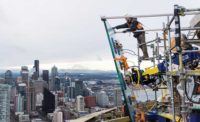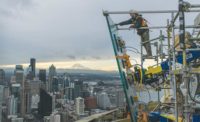ENR 2020 Top 25 Newsmakers
Bob Vincent: Thinking Outside the 'Jewel Box' for Seattle Space Needle Renovation

Bob Vincent stands on the deck of Seattle’s Space Needle during the Century Project, the landmark’s largest renovation since opening at the 1962 World’s Fair.
Photo Courtesy of Hoffman Construction

Bob Vincent stands on the deck of Seattle’s Space Needle during the Century Project, the landmark’s largest renovation since opening at the 1962 World’s Fair.
Photo Courtesy of brandsafway


Bob Vincent had a secret. Sitting with his wife, Maureen, in 2015 in a booth at the Space Needle’s former SkyCity restaurant celebrating their shared birthday, he’d just learned his longtime employer Hoffman Construction landed the contract of a lifetime: to renovate the iconic Seattle landmark. And he couldn’t say a word.
“I was thinking how amazing this is going to be afterward and how much of history we were sitting in right now,” Vincent says. “I wanted her to experience that.”
The Hoffman project manager is familiar with other seemingly once in a lifetime projects—his past work includes the Seattle Central Library and the Frank Gehry-designed Museum of Pop Culture. But the Space Needle renovation took logistics to a whole new plane, described by Vincent as building a ship in a bottle.
Karen Olson, chief operating and chief marketing officer at the Space Needle Corp., says the concept for the Century Project was to “get out of the way of the view” and transform the disc, set 520 ft in the air, into a jewel box in the sky. The project replaced obstructions with 196% more glass, including floor-to-ceiling glass panels, an outdoor observation level with open-air glass walls and glass benches and an upper observation deck connected by a cantilevered steel and glass Oculus Stairs to The Loupe, the world’s first and only rotating glass floor.
The Space Needle remained open to the public during the renovation. Limited workspace, with access via one elevator during day hours, created an enormous logistical challenge.
To avoid the elevator choke point and large crane costs, Vincent enlisted BrandSafway to create a suspended, retractable 135-ft-dia platform connected to the landmark’s upper structure 500 ft above ground, comprised of a 16-ft-wide suspended ring in three sections, each connected with an 8-ft walkway. A weather barrier could withstand 115 mph winds.
Vincent’s next challenge was installing glass panels weighing up to 2,100 lb each. Hoisting each panel took 10 minutes. Due to Seattle’s wind, the panels could’ve become dangerous windmills. Vincent’s team developed motorized fans mounted to a custom spreader bar attached to the glass panels and controlled via remote from the ground to keep the panels from spinning during hoist. On the observation deck, a robot built by Breedt Production Tooling and Design grabbed each panel to maneuver it into place.
Kevin Koester, president of Apex Steel Inc., met Vincent in the 1990s and says his talent is “his ability to think outside the box and not handcuff us to our ideas.” Apex designed a one-of-a-kind gantry crane that was brought up piece by piece via the elevator and assembled by hand on the structure’s deck. “The fact that he is open to ideas, and his collaboration to provide his customers with the product they are looking for—that is the No. 1 thing I respect about Bob.”
John May, branch manager at BrandSafway, also met Vincent in the late 1990s. “I was a bit blown away by Bob’s absolute involvement—he’s level-headed and as serious as can be when it comes to project safety—a huge priority,” says May.
Vincent says he is most proud that the Space Needle will be the base of millions of memories, like the one he shares with his wife.
“At the end of the day, seeing everybody and seeing how they enjoy the experience and how the customer takes care of the landmark and how they love the space … that stands out,” he says.






